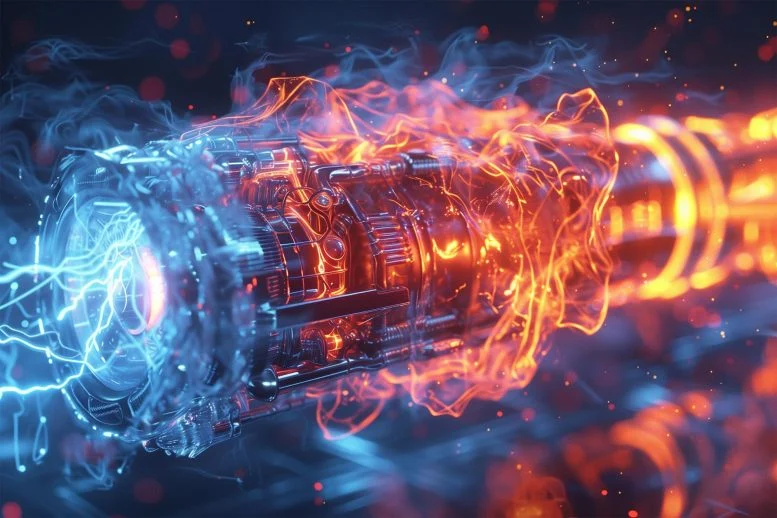
By Tokyo University of Science November 29, 2024
Collected at: https://scitechdaily.com/clean-energy-breakthrough-turns-waste-heat-into-usable-electricity/
Researchers have demonstrated a new method for converting heat to electricity using tungsten disilicide, showing potential for more efficient thermoelectric devices that could revolutionize energy efficiency in various applications.
Thermoelectric materials, which convert heat into electricity, play a crucial role in capturing waste heat and transforming it into usable power. These materials are particularly beneficial in industries and vehicles where engines produce significant waste heat, enhancing energy efficiency by generating additional electricity. They also hold promise for portable power applications, such as remote sensors and satellites, where traditional power sources may not be feasible.
Exploring Transverse Thermoelectric Devices
Traditional thermoelectric devices, known as parallel thermoelectric devices, generate voltage along the same direction as the heat flow. These devices rely on two types of parallel materials, p-type and n-type, which produce voltages in opposite directions. When connected in series, they create a stronger voltage, but this configuration increases the number of contact points, leading to higher electrical resistance and energy loss.
Transverse thermoelectric devices, on the other hand, generate electricity perpendicular to the heat flow, offering a distinct advantage. With fewer contact points, these devices enable more efficient energy conversion. A promising class of materials for these devices includes those with “axis-dependent conduction polarity” (ADCP), also known as goniopolar conductors. These materials conduct positive charges (p-type) in one direction and negative charges (n-type) in another. However, despite their potential, the transverse thermoelectric effect (TTE) has been less explored—until now.

Breakthrough in Transverse Thermoelectric Conversion
In this view, a research team from Japan, led by Associate Professor Ryuji Okazaki from the Department of Physics and Astronomy at Tokyo University of Science (TUS), including Mr. Shoya Ohsumi from TUS and Dr. Yoshiki J. Sato from Saitama University, achieved TTE in the semimetal tungsten disilicide (WSi2). Although previous studies have shown that WSi2 exhibits ADCP, its origin and the anticipated TTE have not been detected in experiments.
“Transverse thermoelectric conversion is a phenomenon that is gaining attention as a new core technology for sensors capable of measuring temperature and heat flow. However, there are only a limited number of such materials, and no design guidelines have been established. This is the first direct demonstration of the transverse thermoelectric conversion in WSi2,” explains Prof. Okazaki.
Their study was published on November 13, 2024, in the journal PRX Energy.
Insights From the Study on Tungsten Disilicide
The researchers analyzed the properties of WSi2 through a combination of physical experiments and computer simulations. They measured the thermopower, electrical resistivity, and thermal conductivity of a WSi2 single crystal along its two crystallographic axes at low temperatures. They found that the ADCP of WSi2 originates from its unique electronic structure, featuring mixed-dimensional Fermi surfaces. This structure reveals that electrons and holes (positive charge carriers) exist in different dimensions.
A Fermi surface is a theoretical geometrical surface that separates occupied and unoccupied electronic states of charge carriers inside a solid material. In WSi2, electrons form quasi-one-dimensional Fermi surfaces and holes form quasi-two-dimensional Fermi surfaces. These unique Fermi surfaces create direction-specific conductivity, enabling the TTE effect.
The researchers also observed variations in how these charge carriers conduct electricity from sample to sample, consistent with previous studies. Using simulations based on first principles, the researchers showed that these variations were due to differences in how charge carriers scatter due to imperfections in the crystal lattice structure of WSi2. This insight is key to fine-tuning the material and developing reliable thermoelectric devices. Further, they demonstrated direct TTE generation in WSi2 by applying a temperature difference along a specific angle relative to both crystallographic axes, resulting in a voltage perpendicular to the temperature difference.
“Our results indicate that WSi2 is a promising candidate for TTE-based devices. We hope this research will lead to the development of new sensors and the discovery of new transverse thermoelectric materials,” says Prof. Okazaki.
By elucidating the mechanism of TTE generation in WSi2, this study takes a step further toward advanced materials that can convert heat into electricity more efficiently, leading to a greener future.
Reference: “Transverse Thermoelectric Conversion in the Mixed-Dimensional Semimetal WSi2” by Shoya Ohsumi, Yoshiki J. Sato and Ryuji Okazaki, 13 November 2024, PRX Energy.
DOI: 10.1103/PRXEnergy.3.043007

Leave a Reply